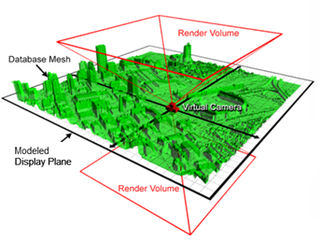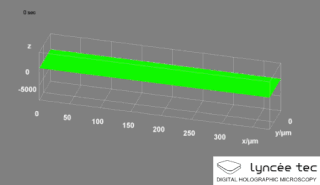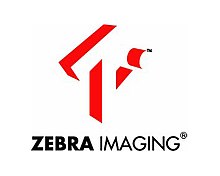
Holography is a technique that enables a wavefront to be recorded and later reconstructed. It is best known as a method of generating real three-dimensional images, but also has a wide range of other applications. In principle, it is possible to make a hologram for any type of wave.

The Holodeck is a fictional device from the television franchise Star Trek which uses "holograms" to create a realistic 3D simulation of a real or imaginary setting, in which participants can freely interact with the environment as well as objects and characters, and sometimes a predefined narrative.

A 3D display is a display device capable of conveying depth to the viewer. Many 3D displays are stereoscopic displays, which produce a basic 3D effect by means of stereopsis, but can cause eye strain and visual fatigue. Newer 3D displays such as holographic and light field displays produce a more realistic 3D effect by combining stereopsis and accurate focal length for the displayed content. Newer 3D displays in this manner cause less visual fatigue than classical stereoscopic displays.
A volumetric display device is a display device that forms a visual representation of an object in three physical dimensions, as opposed to the planar image of traditional screens that simulate depth through a number of different visual effects. One definition offered by pioneers in the field is that volumetric displays create 3D imagery via the emission, scattering, or relaying of illumination from well-defined regions in (x,y,z) space.

Autostereoscopy is any method of displaying stereoscopic images without the use of special headgear, glasses, something that affects vision, or anything for eyes on the part of the viewer. Because headgear is not required, it is also called "glasses-free 3D" or "glassesless 3D". There are two broad approaches currently used to accommodate motion parallax and wider viewing angles: eye-tracking, and multiple views so that the display does not need to sense where the viewer's eyes are located. Examples of autostereoscopic displays technology include lenticular lens, parallax barrier, and may include Integral imaging, but notably do not include volumetric display or holographic displays.

Holographic data storage is a potential technology in the area of high-capacity data storage. While magnetic and optical data storage devices rely on individual bits being stored as distinct magnetic or optical changes on the surface of the recording medium, holographic data storage records information throughout the volume of the medium and is capable of recording multiple images in the same area utilizing light at different angles.
Lloyd Cross is an American physicist and holographer.

A hogel is a part of a light-field hologram, in particular a computer-generated one. It is considered a small holographic optical element or HOE and that its total effect to that of a standard hologram only that the resolution is lower and it involves a pixelated structure. An array of these elements form the complete image of a holographic recording, which is typically displayed in 3D free-viewing device.
Computer-generated holography (CGH) is the method of digitally generating holographic interference patterns. A holographic image can be generated e.g., by digitally computing a holographic interference pattern and printing it onto a mask or film for subsequent illumination by suitable coherent light source.

Stephen Anthony Benton was the E. Rudge ('48) and Nancy Allen Professor of Media & Sciences, and the Director for Center for Advanced Visual Studies (CAVS) at Massachusetts Institute of Technology. He was the inventor of the rainbow hologram and a pioneer in medical imaging and fine arts holography. Benton held 14 patents in optical physics and photography, and taught media arts and sciences at MIT.

Australian Holographics was a laboratory based in Adelaide, South Australia. It was established in 1989 with the specific objective to produce high quality large format holograms. After two years of research and development, the company began commercial operations in 1991. The laboratory eventually shut down in 1998.
The International Hologram Manufacturers Association (IHMA) is a not for profit organisation based in Sunbury-on-Thames designed to represent and promote the interests of hologram manufacturers and the hologram industry, worldwide. Founded in 1993, the association currently represents 89 members worldwide, and hosts an awards ceremony each year at the HoloPackHoloPrint conference designed to reward those whose outstanding contributions to holography advance the industry. The association has secretariat offices in both Europe and America.
A holographic display is a type of 3D display that utilizes light diffraction to display a three-dimensional image to the viewer. Holographic displays are distinguished from other forms of 3D displays in that they do not require the viewer to wear any special glasses or use external equipment to be able to see the image, and do not cause the vergence-accommodation conflict.

Digital holographic microscopy (DHM) is digital holography applied to microscopy. Digital holographic microscopy distinguishes itself from other microscopy methods by not recording the projected image of the object. Instead, the light wave front information originating from the object is digitally recorded as a hologram, from which a computer calculates the object image by using a numerical reconstruction algorithm. The image forming lens in traditional microscopy is thus replaced by a computer algorithm. Other closely related microscopy methods to digital holographic microscopy are interferometric microscopy, optical coherence tomography and diffraction phase microscopy. Common to all methods is the use of a reference wave front to obtain amplitude (intensity) and phase information. The information is recorded on a digital image sensor or by a photodetector from which an image of the object is created (reconstructed) by a computer. In traditional microscopy, which do not use a reference wave front, only intensity information is recorded and essential information about the object is lost.
Specular holography is a technique for making three dimensional imagery by controlling the motion of specular glints on a two-dimensional surface. The image is made of many specularities and has the appearance of a 3D surface-stippling made of dots of light. Unlike conventional wavefront holograms, specular holograms do not depend on wave optics, photographic media, or lasers.

Yves Gentet is a French engineer and artist, known for the invention of a creative method of holograms in colour Ultimate and a 3D holographic printer Chimera.

Euclideon Pty Ltd is an Australian computer software company known for a middleware 3D graphics engine, called Unlimited Detail. Euclideon is also the parent company and operator of Holoverse, a 'holographic entertainment centre' located on the Gold Coast, in Queensland, Australia. Euclideon claims that Unlimited Detail is based on a point cloud search engine indexing system and that the technology can provide 'unlimited graphics power', proposing it as a replacement for polygon-based rendering.

Dieter Jung is a German artist working in the field of holography, painting and installation art. He lives and works in Berlin.

Windows Mixed Reality is a platform introduced as part of the Windows 10 and 11 operating system, which provides augmented reality and virtual reality experiences with compatible head-mounted displays.

Joseph Rosen is the Benjamin H. Swig Professor in Optoelectronics at the School of Electrical & Computer Engineering of Ben-Gurion University of the Negev, Israel.













